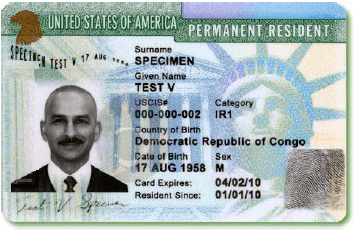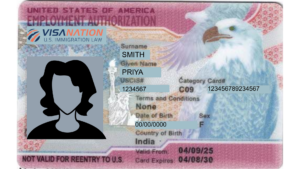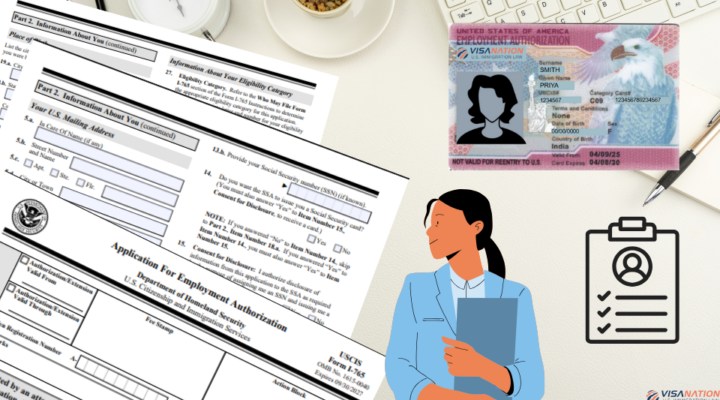When individuals consider immigrating to the United States, their thoughts usually sway toward a green card. While permanent residency is a common goal, other options are available that would allow you to work in the United States until a green card is issued. An Employment Authorization Document (EAD) allows you to work legally in the U.S. while you have a pending Immigration Petition for Permanent Residence or other nonimmigrant visa. The EAD permits non-citizens to legally work in the United States for a U.S. employer. In this post, we’ll explore the similarities and differences between EAD cards vs green cards, as well as the timeline and process.
What is an EAD Card: Employment Authorization?
An EAD, commonly known as a work permit, is a legal document issued by the USCIS. It grants the holder the right to work in the United States for a specified period, typically one or two years, but it can vary based on the immigration situation.
There are two types of EADs:
- One is linked to a green card application
- The other is independent of a green card.
Green Card-Based EAD
A green card-based EAD is issued to those who have an active green card application being processed. While a green card on its own covers both permanent residence and a work permit, in most cases, the processing time is quite lengthy.
To allow applicants to work and earn a living while waiting for their green cards, a green card applicant can concurrently file their I-765 Employment Authorization Document petition when they file their I-485 Adjustment of Status Application.
Typically, the USCIS issues the EAD before the green card, which serves as temporary authorization to work. An EAD issued for this purpose will automatically expire the moment the applicant receives their green card. Both the green card and EAD applications can be submitted to the USCIS at the same time. While your green card processing may take years, a properly filed EAD application is processed within 60 to 90 days.
Standalone (Regular) EAD
Unlike the green card-based EAD, the regular EAD refers to a nonimmigrant work permit and is not tied to a green card application process. According to the USCIS, you are eligible to apply for an EAD if you:
- Are a person who has sought asylum or refuge in the U.S., as well as their dependents and spouse
- Are an F-1 or M-1 student finishing their studies and want to work under STEM OPT
- Are the spouse (J-2 visa holder) of an exchange visitor (J-1 Visa holder)
- Are the spouses of an L-1 (intracompany transferee), H-1B (Specialty Occupation), E-2 (treaty investor), and E-3 (specialty occupation from Australia) visa holder
- Are filing under VAWA (Violence Against Women Act) or U-nonimmigrant visas (Victims of Criminal Activity)
- Are an employee whose work is related to a diplomatic mission, NATO, or another International Organization
- Are a nonimmigrant with a family-based status (such as a K visa)
It is important to note that just because you fall into one of these categories does not automatically make you eligible for an EAD card. Because each situation comes with different regulations, it is important to work with your immigration attorney to learn if you qualify.
UPDATE: As of April 25, 2025, you may qualify for a 540 day automatic extension of the employment authorization, while your EAD is pending. This extension is for applicants who filed Form I-765, Application for Employment Authorization.
EAD Processing Time 2025
According to USCIS historic data in FY 2025, the average processing time is 2.1 months.
From the time that your EAD is approved and the status shows “Card sent for printing,” you can expect to receive it within 5-7 days. If you have questions about your specific situation, use the USCIS Processing Time Checker.
What can I do if my EAD processing time is taking a long time?
If your application is still processing and it has taken longer than the average processing time at the service center, you can make a service request with USCIS for them to look at your case.
Tip: Early filing is important to avoid employment gaps. Speak to an immigration attorney if you have any further questions regarding your processing status. A consultation with VisaNation may offer all the guidance you need.
What is the Difference Between an EAD Card vs Green Card?
Though an Employment Authorization Card (often referred to as a work permit) and a green card may look similar, they serve different functions and represent different stages in the U.S. immigration process. Essentially, a green card signifies the achievement of permanent residency in the U.S., while an EAD card allows you to temporarily work in the U.S.
A green card primarily serves to recognize the holder as a lawful permanent resident of the United States. Employers are legally obligated to ensure that all employees have the appropriate work authorization within the U.S. Below are some of the key differences.
|
|
Green Card |
EAD |
|
Status |
Permanent Residence |
Temporary work authorization |
|
Duration |
Typically 10 years, or 2 years for conditional residents |
1-2 years, but renewable |
|
Travel |
Allows re-entry to U.S. |
Requires seperate travel documents |
|
Family Sponsorship |
Can sponsor spouse and unmarried children |
Cannot sponsor relatives |
|
Work Authorization |
Authorized to work |
Must be renewed, and work is tied to a specific status |
|
Eligibility for Citizenship |
Yes, after meeting residency requirements |
No, must obtain a green card first |
A Green Card Serves Multiple Purposes
A green card gives you both lawful permanent resident status and the legal right to work in the U.S. With your green card, you do not need any other document to prove your eligibility to work, since that is an inherent benefit of the green card or citizenship.
On the other hand, an EAD is not a stand-alone document on its own. You cannot just come to the United States solely to apply for an EAD. It must be tied to an underlying status to which the EAD will be issued. This may be via a work visa or other means.
Opportunity to Travel Internationally
One significant benefit for green cardholders is the freedom to travel internationally without hassle. If you leave the U.S., your green card allows you to re-enter the country by using your green card. T
his is not the case for those holding only an Employment Authorization Card (EAD). To gain re-entry to the U.S. with an EAD, you must apply for a separate travel document, also known as the Advanced Parole, by filing Form I-131.
Ability to Sponsor Green Card Applications for Relatives
Holding a green card in the United States allows you to sponsor certain immediate family members, enabling them to pursue their paths to permanent residency. Specifically, green card holders can sponsor their spouses and unmarried children. In contrast, having an Employment Authorization Document (EAD) does not allow you to sponsor any relatives.
The privilege to sponsor a broader range of family members, including parents, married children, and siblings, becomes available only when one attains U.S. citizenship. Thus, while an EAD provides the right to work, it doesn’t come with the family reunification benefits inherent to the green card or citizenship status.
Permanent Over Temporary
Validity is another major difference between an EAD and a green card. A permanent green card is typically issued with a ten-year validity period. However, because it is a permanent status, you can always renew it and continue working and living in the U.S. for as long as you’d like.
In contrast, an EAD is issued based on your underlying status in the U.S. If the underlying status ends, your right to work in the U.S. also comes to an end. For example, you may apply for a work permit because you have a pending work visa application. However, if the application is denied, your work permit will become invalid.
The Path to Immigration Made Easy
The immigration lawyers at VisaNation Law Group have extensive experience helping people fulfill their dreams in the U.S. A consultation today can put you on the right path towards visa approval.
Qualification for Citizenship
The United States citizenship law allows foreign nationals to become U.S. citizens through naturalization. Citizenship status gives you the highest privileges in the United States that other statuses don’t enjoy.
For instance, you can vote and run for public office during elections. However, citizenship is only attainable for foreign nationals who have already attained lawful permanent resident status. You cannot become a citizen based on being an EAD holder.

Compared to a green card, an employment authorization card (or work permit) is much more limited in what you can do, although it is available to a wide range of nonimmigrant categories as well as those waiting for pending applications with USCIS. What’s more, unlike green cards, EAD cards can range in their validity period depending on the status of the cardholder.

For instance, an individual who is in the U.S. on a K1 visa may likely apply for an employment authorization card that lasts only 90 days. It’s also worth noting that green cards granted to lawful conditional residents are only valid for a period of two years. In these instances, if the proper steps are not taken to adjust the status to permanent residency, the status has a finite lifespan.
However, once those conditions are lifted and permanent residency is granted. Your green card typically has a validity period of ten years.
Similarities Between a Green Card and an EAD
Rights to Renew Status
Both the green card and the Employment Authorization Document (EAD) typically come with renewal options. The green card initially has a validity period of just two years. Known as a conditional green card, this serves as a probationary period for the holder. To transition to a non-conditional, ten-year green card, you must complete specific procedures to remove these conditions.
Similarly, the validity period of an Employment Authorization Document (EAD) usually aligns with the duration of your nonimmigrant status. If you maintain an underlying status, you can apply for its renewal.
Possible Deportation
Both the green card holder and the EAD holder can be deported from the United States. Though a green card is considered permanent resident status, it is only valid for as long as you maintain the guidelines surrounding your green card status.
If a green card holder is judged to have committed a deportable offense, he or she will be deported. Grounds for deportation include drug-related or sex crimes, terrorism, fraud, and other related offenses. The same thing applies to an EAD holder on a nonimmigrant status. Only those with U.S. citizenship are fully protected from deportation.
What is the EAD category C09P?
EAD C09P is the designation in the code of regulations for the ability to work for those with a pending application for AOS. Since you are applying for an employment authorization document and advance parole simultaneously, the card you get is called a C09P EAD (sometimes nicknamed combo card.) This card is valid for one year. If you have more questions regarding the CO9P, a consultation with VisaNation Law Group immigration attorneys can clear things up for you.
Disadvantages of a Green Card
One of the main drawbacks of a green card is the processing time. Speak to an immigration attorney if you want to know more about the processing time for your given application. Each year, a limited number of employment and family-based green cards are issued. Because the immigrant petitions usually exceed this limit, a backlog has built up for several green card preference levels. Depending on which category of green card you have applied for, you may find yourself waiting a very long time.
For instance, the wait time for an EB-3 green card for residents of mainland China in 2025 is at least 4 years. It is worse for family-based visas. The current wait time for an F4 green card for residents of Mexico is approximately 24 years.
This is because citizens of China and Mexico have filed more petitions than there were available visas, causing certain categories to become over-prescribed. When that happens, the USCIS goes on a first-come, first-served basis. The sooner you file your petition, the sooner a visa number will become available.
Because many people cannot wait that long to begin working, nonimmigrant work visas and EAD cards are two possible methods of obtaining employment in the interim.
EAD to Green Card: What to Expect During Transition
Obtaining an Employment Authorization Document (EAD) is a key milestone for individuals on the path to a U.S. green card. However, holding an EAD does not guarantee permanent residency, it’s a temporary work authorization granted while your green card application is pending. Understanding what to expect during this transition is crucial for managing timelines and avoiding disruptions.
The processing time to receive an EAD may vary depending on the service center. By regulation, the USCIS is allowed up to 90 days to process your EAD application. Your green card place in line is determined by your priority date, which is affected by your visa category and country of origin. For some, the green card may arrive within months of receiving the EAD, for others, it may take several years.
While you are waiting for your green card:
- Ensure your EAD status is current: File for extension about 120 days before expiration
- Travel with caution: You will need an approved Advanced Parole Document (I-131 form) to re-enter the U.S. if you leave
- Stay informed: Monitor the Visa Bulletin and listen to USCIS updates about changes in processing times or policy around your petition.
What is the Process if My EAD Has Expired?
If your EAD card is expired or is about to expire, you are likely wondering how to renew your employment authorization. You will not be able to renew your EAD more than 120 days before it expires.
If it has already expired, then you can file a renewal by submitting an Application for Employment Authorization, Form I-765. Alternatively, if you need a replacement EAD because it contains incorrect information (not the fault of USCIS) or it has been lost, stolen, or damaged, you will need to submit a new I-765 and filing fee, plus the EAD card containing the error.
Employment Authorization Document Renewal
If you plan to continue working in the United States while waiting for your green card or maintaining your underlying immigration status, renewing your Employment Authorization Document (EAD) on time is essential. Failing to do so can lead to gaps in work authorization, which may impact your employment and immigration status. You must file your renewal application before your current EAD expires. USCIS recommends that you don’t request to renew your EAD more than 180 days before the expiration of your EAD. As they generally don’t backdate or postdate the renewal EAD in relation to your current EAD’s validity period.
H4 EAD Rule
New legislation has been enacted for H4 holders who will be eligible for the benefits of employment authorization. To qualify, however, you must meet the necessary criteria.
- The first is that the principal H-1B worker has to have an approved I-140
- OR have been approved for H-1B status under sections 106(a) and (b) of the American Competitiveness in the Twenty-first Century Act.
Once your I-765 is approved, you can work for any U.S. employer part-time or full-time, and may change jobs freely without jeopardizing your H-4 status. Click here to read the full H4 EAD frequently asked questions and answers.
H4 EAD Timeline
- File I-765 Immigrant Petition for Alien Worker
- Submit the appropriate documents to prove eligibility
- USCIS will approve, deny, or send you a request for evidence
- When your petition is approved, wait for your EAD to arrive. You should receive it about 5-7 days after the status says “card sent for printing”
- Receive your card in the mail, you’re set to start working full-time or part-time if you like, and even for more than one employer if you want! USCIS does not limit the sponsor of an H4 EAD holder. Moving from one job to the next will not jeopardize your H4 status.
- As an H-4 visa holder, you also have the right to apply for a green card since H-4s are dual intent.
The EAD timeline will differ slightly depending on your immigration status. Consult your immigration attorney about the most up-to-date steps for your situation.
Frequently Asked Questions (FAQ) for EADs
How long does it take to get a work permit while waiting for a green card?
It typically takes 60-90 days after USCIS receives your properly filed I-765 petition to get a work permit while waiting for a green card.
Can I work while waiting for my work permit renewal?
Yes, if you are eligible for an automatic extension (up to 540 days), you can work while waiting for your work permit renewal.
What happens if my EAD expires?
If your EAD expires, you are currently out of status to continue working in the U.S. This can jeopardize your employment unless your employer is willing to wait.
EAD vs Green Card Recap
If your goal is to work temporarily in the United States, an EAD may be the best option. This is especially true if you are not ready to commit to permanent residency. However, a green card offers more benefits. These include travel freedom, family sponsorship, freedom to switch employers, and a citizenship pathway. Deciding between these two depends on your long-term immigration goals. Again, the EAD vs Green card debate is one best handled by an immigration attorney who can review the specifics of your case.
 Sabrina Saada
Sabrina Saada  Shilpa Malik
Shilpa Malik 
